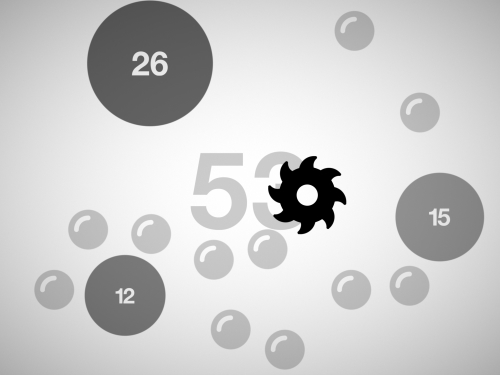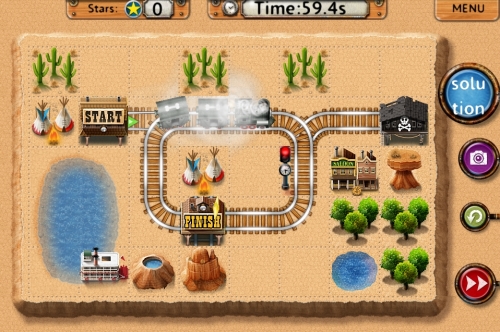There are many kinds of puzzle mechanics, and in general, only a few of them are unsophisticated. As a rule, each game is a mix of various concepts and ideas. Nevertheless, let's try to identify some basic forms.
In word puzzles, the players try to connect letters or symbolic images into words or expressions. This is a very popular class of games and many of them were created long before the first electronic devices were born. Among the popular examples are Crossword, Rebus, Cryptog ram, Hangman, Ghost, Jotto, Anagram, and Scrabble. Some of them operate with words, while others manipulate letters. Dictionaries are used to check existing or correct spelling. There are many word puzzles for mobile devices; one of the examples is an excellent game QatQi (http://qatqi.com) by Zworkbench, which is both very intelligent and magically beautiful.
Number puzzles use different forms of exercises on combinatorics, arithmetic operations, algebra, and so forth. One of the traditional examples is a paper game called Sudoku. The rules of the game are simple: players get a special grid with some digits and many empty cells. The objective is to fill the cells with the correct digits remembering that in each row and column of the grid, as well as in the so-called boxes (blocks with dimension 3 x 3 cells), should be present one digit each from one to nine. The order of digits is irrelevant, and the only condition is that entries cannot repeat. The concept is not complex, but the game itself is very engrossing as it requires players see the big picture of the game field.
One of my favorite instances from the digital age is a smart and elegant game Hundreds (http://playhundreds.com) from Semi Secret Software, LLC; it has perfect graphics (minimalistic artwork and neat typography based on the Helvetica typeface) and very attractive gameplay. The player should generate a sum of elements that is equal to one hundred. This is tricky because there can be some obstacles, so the game requires good reaction and computation skills.
The following is a screenshot from a number puzzle game, Hundreds:

Sound can be a basis for puzzles as well provided a game designer can find an adequate use for it. Let's take for example a wonderful game called Circadia (http://circadiagame.com), created by game designer Kurt Bieg:

The objective is to generate a "burst" (a colored circle that constantly increases in dimensions) and connect it to a special white dot. The behavior of each burst is specified by a height of music tone. There are slow bursts and fast bursts, and the player should select the correct moment to start each one so they reach the white dot simultaneously. It is also beautiful because by playing the game, the player performs simple melodies.
In transport puzzles, the player operates various forms of blocks, trying to deliver this cargo to a specified destination. So, the objective is to find a connection between an object and its positions on the game board. Good examples of such games are the famed 15 puzzle and various versions of sliding puzzles, where the player has to assemble an image by moving its parts in a box, such as Klotski. The following is an example of transport puzzles:

Rail maze 2 is a transport puzzle from Spooky House Studios UG (haftungsbeschränkt)
One of the most famous transport puzzles is the folkloric game—The fox, the goose, and the bag of beans. A farmer has to transport some cargo to the opposite bank of a river; this is a problem because the boat is very small and only one object can be taken aboard at a time and the other two must be left unattended. The player must manage connections between the elements, not leaving contradicting objects together.
This puzzle can easily be incorporated into digital form, and this was skillfully proved by the creators of an amazing and debonair game Girls Like Robots (http://www.popcannibal.com/girlslikerobots), published on the App Store by [adult swim]. The player must manipulate seating order for various types of characters. Some company or surroundings make some characters happy, while others make them very angry. In the world of video games, the role model for a transport game is of course the classic Sokoban, created by Hiroyuki Imabayashi in 1981; the main character has to move crates inside a warehouse, placing them in the right positions.
Point connection is a class of puzzles, where the player needs to connect two points by drawing a line in a maze. There are usually some conditions or obstacles that make the objective harder to attain. The concept was immortalized by Pipe Mania, designed in 1989 by The Assembly Line. The idea was very visual: there was a starting point (a source of water) and a finish point (a sink); a player had to construct a pipeline between them using pipe pieces which the game gave him at random. The idea was elementary but very addictive.
Besides the water and pipes, other metaphors can be used as well, for instance, light (or lasers) in combination with mirrors. Such a concept is utilized by the Guide The Light game (http://www.appynation.com/apps/guide-the-light), published by AppyNation Ltd. A player opens doors by guiding color light beams onto special sensors. The following is a screenshot from Guide The Light:

The Guide The Light puzzle game lets us guide light beams through a maze, by using mirrors and other elements to control the light
The Points-connection paradigm took on new heights when Valve Corporation developed the critically acclaimed Portal, a game where the player can connect locations in 3D space. This is something mind blowing!
Physics-based puzzles include various types of games that use simulations of physics (based either on the traditional laws of Newton or their own interpretation of forces and interactions) to create game situations. They are very popular because the gameplay is vivid, spectacular, and realistic. But the game devices can easily calculate complex interaction and collisions of the objects; also, many modern SDKs include libraries for physics simulations, so game developers need not create special engines. Usually physics-based puzzles are about experiments with gravity: the player throws objects, rolls them down from curved hills, builds some constructions from blocks, or contrarily, tries to bombard some structures. One of the most famous games of this kind is of course Angry Birds (http://www.angrybirds.com), created by Rovio Entertainment, which is not just a video game title but an element of popular culture.
Another popular example is World of Goo (http://2dboy.com/games.php) developed by 2D Boy, featuring an elaborate game concept and splendid graphics. To the game's credit, it uses not only gravity but some properties of materials, such as flexibility and tension, as well. A player should create complex structures to reach the exit point; he has to remember to achieve the right balance and not pull the construction down accidentally. The experience is very unusual. Another interesting element of the game is the simulation of liquids; some sort of fluid dynamics is used in this puzzle.
Simulation of water is a unique opportunity to create an original and spectacular gameplay. There is a special class of physics-based puzzles that try to do that. A popular entry is a game called Sprinkle (http://www.sprinklegame.com/sprinkle/) from Mediocre AB that lets a player extinguish fire by using a special water pump. So, besides a brilliant demonstration of water dynamics, the title also features a simulation of fire.
The following is a screenshot from a puzzle game Sprinkle that successfully simulates both water and fire dynamics creating unique game situations:

Many actual natural phenomena can be turned into a story driver for a game; we only need to switch on the fantasy.
Tile-matching puzzles include a very wide range of games that require the players to assemble a uniform set of specified objects. The most common association is, of course, a jigsaw puzzle, which became a symbol of puzzles of any type. Jigsaw's game piece is now a well-recognizable icon. This element illustrates all the principles most of puzzles have: the geometric shape with cutouts and ledges indicates that can be connected with another shape, but a picture fragment printed on its surface is a hint to the fact that the elements are part of something bigger. The world of video games has its own icon, Tetris, which also features complex geometric shapes as main game pieces (they are known as tetraminos ). Tile matching is one of the popular mechanics for video games, because it can be interpreted in thousands of ways, making game designers switch on their creativity. Even tried-and-true concepts can be reinvented; for example, there is a game called Dream of Pixels by Dawn of Play, which is a pretty talented allusion to Tetris. It uses tetraminos, traditional game pieces from Tetris, but the main objective is different. Instead of creating packs of elements on the screen, the player should extract individual shapes from a bunch of cubes.
As the term suggests, a match-three game is a tile-matching puzzle, where a player should match at least three elements (in reality, many games let us match two items). He/she must construct or find such sequences in the array of typical objects. This is one of the most convenient types of puzzles to start with because the core of the game is not complicated and can be developed even by a novice. At a basic level, it is all about manipulations with a two-dimensional array of data (nevertheless, a match-three puzzle can be three dimensional as well). There is a total freedom in game ornamentation, and the game tiles may have a wide spectrum of designs. The following figure shows the basic match-three puzzle tile options:

The general rule of a match-three game is pretty elementary: if there are at least three (or two; this depends on a game mode) identical tiles nearby (horizontally, vertically, or both), such elements should be removed from the game board and neighboring items take their places. The main objective is to eliminate as many tiles as possible.
The conditions are simple, but the power of such puzzles lies in their ability to be widely customized and reinvented. Many new options can be introduced to work with arrays of tiles and to affect their content. There are four cornerstones of a match-three game:
- Game tiles: These are the elements that are used at the game board as the main game pieces.
- Array of elements: This is the matrix of data where all the game tiles are stored.
- Sequence: This is a line of identical game tiles.
- Trigger: This is a force that affects the array of elements. For instance, a player's touch.
First of all, you need to select the number of game tiles you will use. The spread should not be too large because the number of elements directly affects the probability of connections between them. To calculate a pretty accurate probability of some elements appearing in a row, some advanced methods should be used, for example, methods based on the binomial distribution model. It is not necessary to calculate manually by using special tables of binomial probabilities; there are special applications and tools that can help with this, for example, an iOS application, Probability, from All Dreams Ltd.
A rough model can be used to illustrate the principle. For instance, there are five types of tiles in the game, each one a different color, and we have only one tile displayed on the screen. The probability of one particular type of tile, the red one for example, appearing is 1/5 (five items and only one is red). Now, let's try to calculate the chances of combination when there are two tiles on a screen and both of them are red: 1/5 x 1/5 = 1/25. By adding only one tile, you can change the probability significantly: 1/6 x 1/6 = 1/36. In case you have seven tiles, the chances are 1/49. The red is almost twice as unlikely to appear as in the puzzle with five game pieces. As you can see, the game becomes harder and more unpredictable when the number of elements is increased. That is the mathematical side, but let's bear in mind that there is a psychological aspect: for the player, it is more comfortable to be familiar with a few elements, not with a dozen. Therefore, it is better to dwell on six or seven game tiles (there will also be special elements, which will bring the overall number up to eight or nine). For example, the game Bejeweled, which is now a popular role model for match-three gaming, created by Pop Cap Games, features seven basic game tiles.
The following figure shows the tiles for such match-three games:

The difference between tiles should be easily noticeable and obvious to exclude situations when players are not sure if items are identical or not. In an ideal scenario, the tile has an unique geometric shape to better express its individuality, but you can content yourself only with color coding (don't forget about the accessibility mode based on patterns or icons): red, green, yellow, blue, purple, and so forth. Chromatic colors will designate main game elements, but achromatic ones (white, black, and shades of black) will decorate special items.
The array of elements can have two modes of sensitivity:
- Passive: The game does not see the elements inside the array until the player performs some action (taps the screen, for example). After that, it analyzes the content that was touched and tries to determine the boundaries of a tile sequence; only elements specified by the player's tap are taken into account, and the other ones are ignored.
- Active: The array responds to each change of element's order. If there is a correct matching on the game board, the game tries to recombine the array on the spot. The game works with a whole array, not with one active sequence. Such an approach is suitable for tile-matching puzzles with action-oriented rules and fast gameplay because it works in real time and can easily respond to up-to-the-minute changes of the game situation.
The passive mode is not complicated, but that does not mean that it has no advantages. Such puzzles have their own value: they are slow paced and require more tactical vision to play well. Active arrays at their turn are faster and are scurrying.
The arrays can be dynamic ; this means that the game tiles are moving slowly (for example, from top to bottom). Such mechanics may add some suspense to the game because players will be afraid to lose tiles and will act more quickly trying to note all matches till tiles leave the screen.
